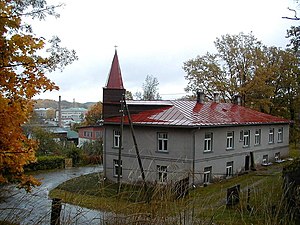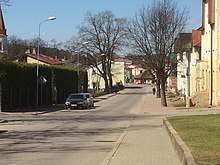Smiltene
Smiltene (![]()
Smiltene | |
|---|---|
Town | |
 | |
 Flag  Coat of arms | |
 Smiltene Location in Latvia | |
| Coordinates: 57°26′N 25°54′E | |
| Country | |
| Municipality | Smiltene |
| Town rights | 1920 |
| Government | |
| • Mayor | Edgars Avotiņš |
| Area | |
| • Total | 7.8 km2 (3.0 sq mi) |
| Elevation | 153 m (502 ft) |
| Population | |
| • Total | 12,690 |
| • Density | 710/km2 (1,800/sq mi) |
| Time zone | UTC+2 (EET) |
| • Summer (DST) | UTC+3 (EEST) |
| Postal code | LV-4729 |
| Calling code | +371 647 |
| Number of city council members | 15 |
Name
Its original name was Smiltesele (the ending probably came from the Russian "selo" - village), later it was called Smilten in German before adding the Latvian ending and thus becoming Smiltene.[1]
Geography
Smiltene is located in the northern part of the Vidzeme Highland on the banks of the river Abuls (Abula). It was formerly in Valka District prior to the reorganization of 2009, which eliminated districts, and placed the town as part of Smiltene Municipality. The town centre is 106 metres above the sea level, the highest spot is on Klievu street - 145.14 metres above the sea level. There are three possible meteorite craters in Smiltene.
History
The area around Smiltene was a part of the Latgalian lands of Tālava. After Crusaders had taken over most of the modern day Latvia, the area was part of the lands of the bishop of Riga. In 1359 on the steep hill near the river Abuls was built a castle. The tradesmen and craftsmen village around it - Smiltestele - first is mentioned in historical documents in 1427, since 1523 it was called a town. During the Livonian war the castle and the town were brought to ruin by the army of Ivan the Terrible. Under Polish–Lithuanian Commonwealth Smiltene and the area surrounding it were controlled by the starosta Kaspar Mlodecki.
In the early stages of the Great Northern War Smiltene was burnt down by the Russian army. After the war the area became devastated due to hunger and Bubonic plague. In 1708 the Swedish government built a new church and started the restoration of the village of Smiltene.
In 1760 the Russian empress Catherine II gave Smiltene manor as a present to the Governor-General Georg von Braun (Yuri Broun). During this time the manor was restored, from 1763 to 1771 were built manor buildings which have been still preserved. After the death of Braun his heirs sold the manor to the Riga merchant J.S.Baundau whose family had it for almost 100 years.
In 1893 the Smiltene manor was bought by Paul Lieven (of the Lieven family of Baltic German aristocrats), who split the land into parcels – thus creating the foundations of the modern day city. In 1901 electricity was connected in the Smiltene manor house. For Lieven's money a hospital, sawmill and electric station were built in Smiltene in 1903. After his suggestion and with his financial support a narrow gauge railway was built from Smiltene to Valmiera.[2]
In 1920 Smiltene was granted the town rights in the Latvian Republic. In 1935 there were more than 400 dwelling houses and many industrial companies in Smiltene. On September 22, 1944 during the retreat of the Nazi army at least 297 buildings were destroyed in Smiltene.
In 1950 Smiltene become the administrative centre of the newly created Smiltene District.[3] In 1959 the district was merged with Valka District, which existed until the administrative territorial reform of 2009.
Sights
- Ruins of the Smiltene castle (14th century)
- the Smiltene Lutheran church
- Kalnamuiža (the Smiltene manor house)

Sports
The most popular sports among the Smiltene youth is football,[4] the local club Abuls Smiltene however is not especially strong and is one of the outsiders of the Latvian First League. Since 1969 there is also an ice hockey team in Smiltene.[5]
Twin towns — sister cities
Smiltene is twinned with:[6]
Notable people
- Inese Vasiljeva (teacher)
- Artis Gāga (saxophonist)
- Pēteris Sils (poet)
- Andīna (poet)
- Kārlis Puriņš (professor at the University of Latvia, minister of finance of Latvia from 1918 to 1919)
- Einārs Tupurītis (runner)[7]
- Jānis Akmentiņš (cycling trainer)
References
- The name of Smiltene through time (Latvian)
- Ikauniece, Sandra, ed. (2011). Ziemeļvidzemes ainavas noklusētie stāsti [North Vidzeme landscapes: Silent Stories] (PDF) (in Latvian). Valsts meža dienests [National Forest Service]. p. 98. Archived (PDF) from the original on 5 March 2016.
- History of Smiltene (Latvian)
- In the football history of Smiltene - a victory against Brazil Archived 2008-08-02 at the Wayback Machine (Latvian)
- Always devoted to ice-hockey (Latvian)
- "Sadraudzības pilsētas". smiltene.lv (in Latvian). Smiltene. Retrieved 2019-08-31.
- Calendar of birthdays of notable people from Smiltene (Latvian)
External links
